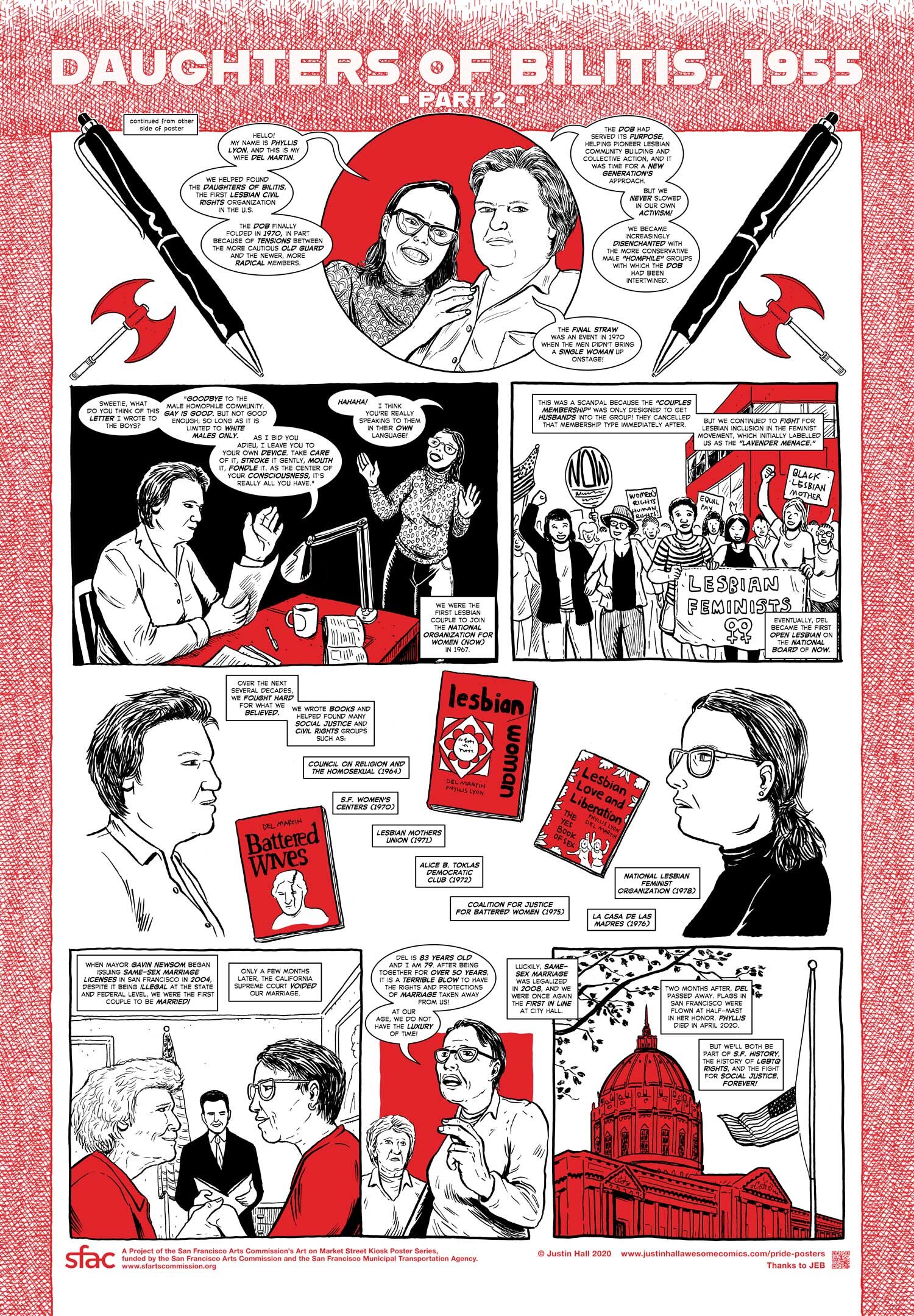Daughters of Bilitis, 1955
The first in the series of posters representing some highlights of the LGBTQ liberation movement, in red to represent the top color of the rainbow flag, is DAUGHTERS OF BILITIS, 1955.
The DOB, considered the first lesbian civil-rights organization, began as a secret social club consisting of four couples. Del Martin and Phyllis Lyon are the most famous of the first members, and this comic is told from their point of view. The poster also details some of their time before the DOB and more about their life and impressive history of activism afterwards.
Phyllis and Del always made clear that they were not the founders of the DOB; that historical honor goes to Rosealie “Rose” Bramberg. She had the idea for the group, and she and her partner Rosemary Sliepen hosted the first meeting at their home. The other couples were Marcia Foster and her partner June (last name not known), and Noni Frey and her partner Mary (last name also not known).
The DOB split up within a year. The working-class couples wanted the group to remain a secret social club, since Rose had started the DOB as a way to dance with other women. But the white-collar couples pushed to make it a public political group. This, of course, brings up important issues of both class and race. Rose and Rosemary both worked in a brush factory, while Del and Phyllis were trained journalists; Rose was Filipina and Mary was Chicana, while all of the white-collar women were White. The very capacity to be public activists reveals relative privilege: While 1950s America was a dangerous place for White, middle-class lesbians, those dangers were greater for women of color and working-class women.
But women of color were involved in the DOB as it moved forward. For example, Black women Ernestine Eckstein and Cleo Bonner were leaders in the movement, and Black writer Lorraine Hansberry famously wrote letters to the DOB magazine The Ladder. An article by Malinda Lo reveals the importance of remembering the women of color who were instrumental to the founding of the DOB.
The DOB’s chapters across the country were subjects of constant surveillance and harassment by local police, the CIA, and the FBI. Wearing men’s clothing was illegal at the time, and the DOB controversially forbade “butch” apparel for their members. The bottom of the first side of my poster illustrates how keeping to a dress code was a survival skill for a public organization whose members were under the threat of imprisonment, even though it came at the cost of the authentic gender expression of some of the members.
Public same-sex dancing was also illegal, and the underground lesbian bars were often raided by the police. Still, there were thriving communities within the gay and lesbian bar scenes at the time that are also important to remember and honor, as I try to do in my posters JOSE SARRIA’S CAMPAIGN, 1961 and TOOL BOX BAR, 1963. These bar scenes were often seen as in opposition to the more assimilationist homophile groups such as the DOB. Nan Alamilla Boyd’s Wide Open Town: A Queer History of San Francisco to 1965, which contains an illuminating interview with Martin and Lyon, portrays this division. I would also recommend the documentary No Secret Anymore: The Times of Del Martin and Phyllis Lyon by director JEB (who was gracious enough to look over this poster for me as well), for footage of Martin and Lyon and to dive deeper into this complex and important history.



